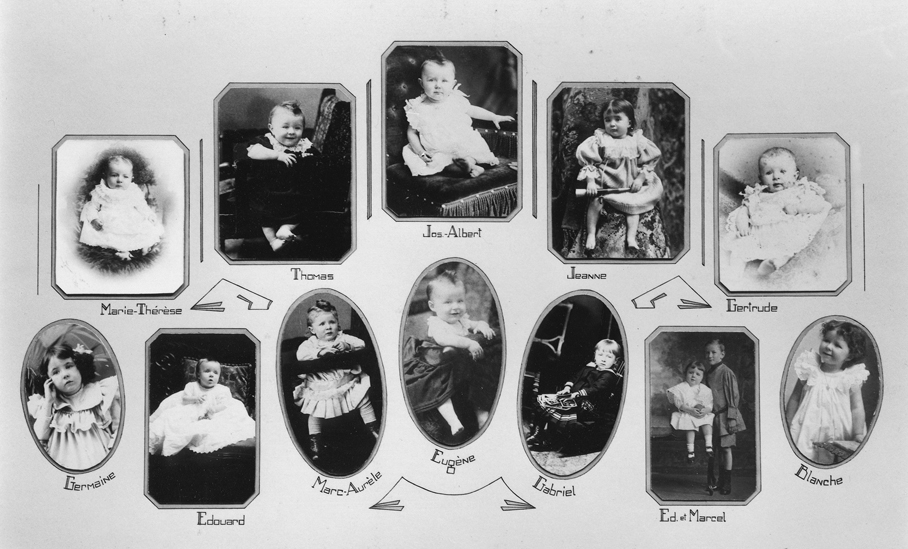
Marc-Aurèle Fortin was born on March 14, 1888, in Sainte-Rose (Laval). His mother, Amanda Fortier, and his father, Thomas Fortin, a lawyer, future judge and liberal deputy, had fifteen children, but seven of them died in infancy.
Fortin took his first drawing and painting courses at the Catholic Commercial Academy of Montreal and at the Monument-National between 1901 and 1904. In 1909, he decided to continue his artistic training by enrolling at the Chicago Art Institute, but he only stayed for two terms. He returned to Montreal in 1910 and found a job as a postal clerk. In his spare time, he painted. He was looking for a different interpretation of Quebec nature that would capture the soul of his country.

From the 1920’s onwards, a new style finally emerged for the artist. The giant elms that shaded the country roads of Quebec exerted a strange fascination on the artist, as did the poplars and maples with their immense branches. He chose to represent them by paying particular attention to their vibrant foliage, which he detailed on a large part of his canvas. His first paintings of his series of large trees were then born under his brush.
Around the same time, he painted his lyrical watercolors with trees pierced like sponges in flamboyant colors. In this style, he painted many landscapes of Laval and the north of Montreal as well as views of the port of Montreal from Île Sainte-Hélène.
In the second half of the 1920s, Fortin began to create splendid pure watercolors. Using this technique, he painted many rural landscapes, but also views of the city of Montreal, which was undergoing a great transformation: the Hochelaga district, which was being urbanized, and the port of Montreal, which was being industrialized and developed to the east. From these urban landscapes, he would also draw his first etchings in 1930. In all, he would have produced about sixty etching plates during his career.

n the late 1920s, Fortin began to enjoy an enviable reputation among critics and others in the cultural community. He exhibited regularly and his work received generally favourable reviews and was occasionally reproduced in newspapers. In 1930, the National Gallery of Canada (now the National Gallery of Canada) was the first museum to acquire one of his works, a watercolour of Hochelaga. This was followed by the Art Gallery of Toronto (now the Art Gallery of Ontario) in 1935 and the Musée de la province de Québec (now the Musée national des beaux-arts du Québec) in 1937.
In November 1933, Fortin travelled to France for nearly four months. On his return, he declared that the future of painting was in America. However, his style had been transformed. Fortin revealed his innovative spirit by conceiving a technique that consisted of painting on grey backgrounds “to describe the warm atmosphere of Quebec skies” and on black backgrounds to “intensify the relationship between light and shadow”. The resulting works were noticed by critics for their decorative qualities which often moved them away from a realistic representation, in some cases even bordering on abstraction.
In 1936, the painter began a series of summer trips that would take him to the region of Quebec City and Île d’Orléans, then to Charlevoix. In the early 1940’s, it was the Gaspé Peninsula that attracted Fortin and in the second half of the decade, the Saguenay. From all these regions, he will bring back many watercolors of which he created numerous variations in his studio.

Always seeking to renew himself and experiment with different techniques, Fortin also indulged in drawing and exploited the possibilities of pastel, charcoal and colored pencils. At the end of the 1930’s, he started to enhance his watercolors with charcoal, Conté pencil and pastel to create what we call his mixed watercolors. At the end of the 1940’s, the artist will discover casein (a kind of milk-based tempera) whose fluidity he exploited on large wood supports among others.
Fortin was at the height of his talent and continued to receive recognition from the Quebec art world during this period. In 1938, he won the Jessie Dow Prize; in 1942, he was made an associate member of the Royal Canadian Academy of Arts; and in 1943, he was represented by the gallery L’Art français, which is responsible for the sale and promotion of his works. He was also the subject of sections in several significant works on Canadian painting.
In the early 1950’s, feeling that he was getting older and increasingly affected by poorly treated diabetes, the painter decided to hire Albert Archambault to look after his studio. In 1955, he made him his agent and representative. He entrusted him with the care of numerous works that were either sold cheaply or thrown away indiscriminately. The master, who had nothing of a manufacturer, was even forced by his “manager” to take up his brushes again. But he painted without the conviction and passion that had previously animated him.

Amputated of both legs and almost blind, the artist was then entirely dependent on Archambault who kept him in execrable conditions. In 1966, journalists learned of Fortin’s pitiful state and scandal broke out: “Not yet dead, the vultures are already fighting over the inheritance of the great painter Marc-Aurèle Fortin”, “Millionaire, Marc-Aurèle Fortin is a prisoner of misery in Sainte-Rose” were the headlines.
In 1967, taking advantage of the fact that Archambault’s property was about to be seized for unpaid debts, René Buisson, a friend and collector of the painter, went to his home and succeeded in freeing him from his agent. He then transports him to Macamic in Abitibi where he is treated in a sanatorium. Marc-Aurèle Fortin passed away peacefully on March 2, 1970.